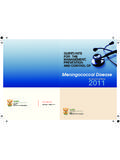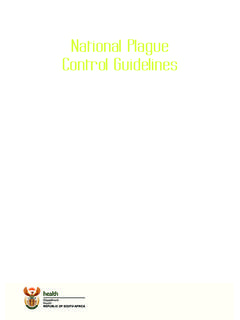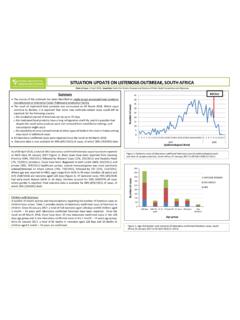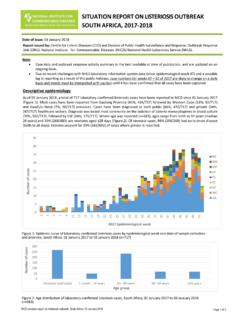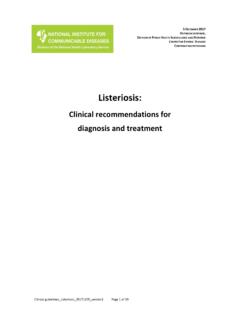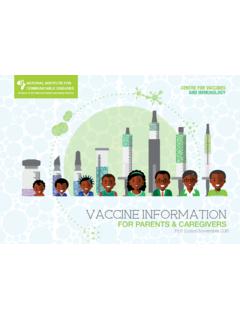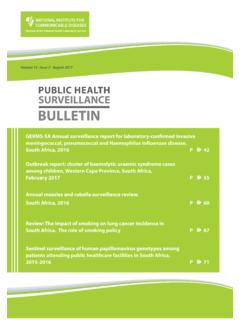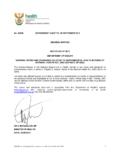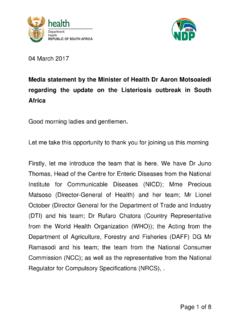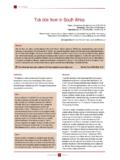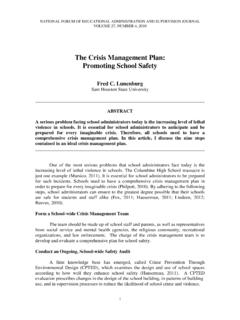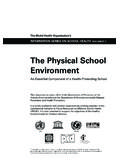Transcription of Situational Report - nicd.ac.za
1 Listeriosis outbreak situation Report - 22/04/2018 1 Situational Report Outbreak Name Listeriosis Country affected South Africa Date & Time of Report 20 April 2018 Investigation start date August 2017 Prepared by National Listeria Incident Management Team (IMT) 1. HIGHLIGHTS A multisectorial incident management team (IMT) has been formed by the National Department of Health (NDoH) to strengthen co-ordination of outbreak response and strengthen health systems to prevent future outbreaks. Funding is being sourced. The number of cases of laboratory-confirmed listeriosis reported per week has decreased since the implicated products were recalled on 04 March 2018, with eight additional cases reported this week.
2 Of the eight cases reported this week, one case occurred in October 2017 and was retrospectively reported. Since the recall, a total of 50 cases have been reported a. Twenty-four (48%) were among neonates 28 days old b. Three (6%) were among children age 1 month to 14 years old As of 17 April 2018, a total of 1 019 laboratory-confirmed listeriosis cases have been reported to NICD since 01 January 2017. 2. BACKGROUND Listeriosis was not notifiable until 15 December 2017. Prior to 2017, an average of 60 to 80 laboratory-confirmed listeriosis cases per year (approximately 1 per week), were reported in South Africa. In July 2017, an increase in laboratory-confirmed cases of listeriosis was reported to National Institute for Communicable Diseases (NICD) which was followed by investigations into the reported increase.
3 On 05 December 2017, the listeriosis outbreak was declared by the Minister of Health, Dr. Aaron Motsoaledi. The source of the outbreak was identified as ready-to-eat processed meat products manufactured at Enterprise Foods Polokwane production facility. A recall of affected products was initiated on 05 March 2018. 3. emergency MANAGEMENT APPROACH emergency response activities that have been conducted by various stakeholders are continuing and intensifying, including surveillance (detection and investigation of cases), risk communication activities, and food safety legislative review and reform. To inform and support these activities, additional activities will be implemented in a phased approach as follows: Phase 1: Identification of at-risk food processing plants, development of material and training of staff to support inspections of facilities Phase 2: Inspection of at-risk food processing plant and strengthening of district environmental health practitioners Phase 3: Reporting and consolidation of health system strengthening activities, and after action review.
4 4. PUBLIC HEALTH ACTION/RESPONSE INTERVENTIONS 1. CO-ORDINATION A multi-sectoral incident management team (IMT) has been strengthened under the leadership of the Department of Health. This development builds on the initial EOC activation in December, and draws upon appropriate experts from key stakeholders, essential to the control of this emergency and with the skills to strengthen the system for future outbreaks of this nature. Figure 1 (left). Electron micrograph showing two Listeria monocytogenes bacteria, illustrating the single flagellum that makes the organism motile (courtesy Dr Monica Birkhead, NICD) Listeriosis outbreak situation Report - 22/04/2018 2 An updated Listeriosis emergency Response Plan (ERP, April 2018) has been developed and approved by the DG NDoH.
5 The aim of the ERP is to intensify response activities to control and end the current listeriosis outbreak and strengthen health systems to prevent future outbreaks. Response activities are being directed by the designated Incident Manager according to the plan which includes a robust monitoring framework for tracking the progress. A two-day combined meeting of provincial and national stakeholders including health promotion and communications staff, Communicable Disease Co-ordinators and environmental health practitioners, along with NICD and WHO technical experts will be held on 24/25 April to communicate details of the ERP. A WHO Listeriosis Technical Meeting is taking place in Johannesburg on from 19-21 April 2018 attended by delegates from 16 countries from the SADC region and beyond.
6 The aim of the meeting is to share experiences from South Africa, increase awareness of listeriosis and guide countries to start preparing contingency plans to respond and control listeriosis. 2. SURVEILLANCE Descriptive epidemiology 1 019 cases reported from 01 January 2017 to 17 April 2018. The number of reported cases has decreased since the implicated products were recalled on 04 March 2018 (Figure 1). Since week 9 (5 March 2018), cases per week have dropped to fewer than 15/week, with 8 cases reported in week 14. At the height of the outbreak, 30 or more cases were reported weekly. Neonates 28 days of age are the most affected age group (on account of increased vulnerability of pregnant women), followed by adults aged 15 49 years of age (Figure 2).
7 Most cases have been reported from Gauteng Province (59%,579/1 019), followed by Western Cape (13%, 127/1 019) and KwaZulu-Natal (7%, 73/1 019) provinces (Table 1). Figure 2: Epidemic curve of laboratory-confirmed listeriosis cases by epidemiological week (numbered weeks of the year, starting with week 1 in January) and date of sample collection, South Africa, 01 January 2017 to 17 April 2018 (n=1 019) Figure 3: Age distribution and outcome of laboratory-confirmed listeriosis cases, South Africa, 01 January 2017 to 17 April 2018 (n=1 019) 0510152025303540450510152025303540451357 9111315171921232527293133353739414345474 951135791113151720172018 Number of casesEpidemiological weeks0100200300400500 28 days1 Month -14 years15 - 49years50 - 64years 65 yearsAgeUnknownNunber of casesAge groupOUTCOME PENDINGDISCHARGEDDIEDRECALL Listeriosis outbreak situation Report - 22/04/2018 3 Table 1.
8 Number of laboratory-confirmed listeriosis cases and deaths by province, where outcome data is available: Province Outcome available (% of total cases in RSA) Number of deaths (% of those with outcome available) Total cases (% of cases in all provinces) Gauteng 370 ( ) 105 ( ) 597 ( ) Western Cape 113 ( ) 29 ( ) 127 ( ) KwaZulu-Natal 47 ( ) 18 ( ) 73 ( ) Mpumalanga 45 ( ) 11 ( ) 47 ( ) Limpopo 33 ( ) 7 ( ) 52 ( ) Eastern Cape 30 ( ) 11 ( ) 53 ( ) Free State 30 ( ) 8 ( ) 35 ( ) North West 25 ( ) 7 ( ) 29 ( ) Northern Cape 5 ( ) 3 ( ) 6 ( ) Total 698 ( ) 199 ( ) 1 019 (100) Following a recall of implicated products, the number of cases are going down.
9 However, it is anticipated that cases could still be reported for the following reasons: a. The incubation period of listeriosis can be up to 70 days b. The implicated products have a long shelf life and it is possibly that despite the recall some products have not been removed from retail or consumer s homes c. Cross-contamination at retail and in the home can occur Analysis by exposure a. Before recall 106 interviews done before the recall 90/106 (84%) of people interviewed reported consuming ready-to-eat processed meat products 88/90 (97%) of people who consumed ready-to-eat processed meat products had consumed polony o Post recall 23 interviews done post recall.
10 15/23 (65%) of ill people or their proxy reported consuming or handling polony prior to their illness onset Monitoring for additional cases will continue, and any new cases reported will be interviewed. 3. LABORATORY NICD: a. Of the 1 019 laboratory-confirmed cases, whole genome sequencing of 442 isolates has been completed to date, with 92% (406/442) identified as Sequence Type 6 (ST6), 8% (36/442) representing 11 other Sequence Types (ST1, ST101, ST2, ST204, ST219, ST224, ST3, ST5, ST54, ST8, and ST876). b. Whole genome sequencing has also been conducted on 411 isolates from food and environmental samples to date. Thirty-eight isolates (9%) have been identified as ST6, and 19 Sequence Types account for the remainder.
